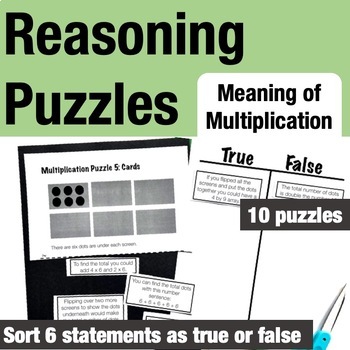Reasoning Puzzles: Multiplication Enrichment Activities for Math Talk
- PDF
Description
In these no prep true/false multiplication puzzles, students practice multiplication concepts using repeated addition, equal groups, arrays and multiplication expressions. These are awesome tasks for when students need enrichment, or to use in a small group for your students who might be struggling with the concepts.
These also work great as math warm ups, centers, or early finisher activities! There are 10 no prep puzzles are easy to print and just hand out for instant engagement. In this activity, students decide for themselves whether six statements are true/false about a given puzzle. You can then have them engage in math talk to defend their thinking, and critique the reasoning of others. The puzzles get more difficult as you go for easy differentiation as well.
They will sort true and false statements with a picture puzzle that explores:
Puzzle #1: repeated addition as a number sentence
Puzzle #2: single digit multiplication represented by an array
Puzzle #3: equal groups of dots
Puzzle #4: rectangular array where some dots are hiding
Puzzle #5: equal groups where only one group is showing
Puzzle #6: equal groups with larger amounts to multiply
Puzzle #7: multiplication on a number line as repeated addition
Puzzle #8: equal groups where dots are hiding on each group
Puzzle #9: two rectangular arrays side by side
Puzzle #10: multiplication equations and expressions
This no prep true and false sort is perfect for fast finishers who need math enrichment activities and problem solving opportunities. Your early finishers will be engaged when they have extra class time in a meaningful way, either working with a partner or small group. They are a little bit like word problems requiring careful reading, and they require critical thinking and promote a deeper understanding of multiplication.
You could have your whole class do this as well for a math warm up to get those math skills ready to go in their brains. Some students may do well with mental math, but it would be a great idea to provide tools/manipulatives for students that may struggle. The visuals connect to real-world math problems as well, with all kinds of real life application.
Please see the preview video to watch the problem-solving skills required to implement this in the best way possible. Create strong mathematicians who beg for more of these puzzles!
Why work on reasoning activities?
The Standards for Mathematical Practice put a focus on the thinking processes of students. There is also some pretty strong research suggesting that students should be engaged in student to student math talk for at least 65% of your math lesson. Giving students these tasks allows them to form their own thoughts, and then work with a team to defend their thinking. If you make it a regular part of your classroom routine (once a week or every other week) students will become more comfortable with math talk.
The puzzles are also fantastic problem solving, critical thinking and deduction activities. This is also a wonderful test prep activity for state testing!
How long does this activity last?
Depending on the ability level of your students, each individual activity can take anywhere from 15 to 30 minutes. There are 10 total puzzles with 6 prompts each in this resource.
How do I assess this project?
You can assess what the students do individually if you have them glue their strips to the true/ false template. If you pull together small groups, you could also assess students on their group work skills and level of participation in their group.
How and when do you use this problem type in class?
There are many ways you can use this activity:
- Fast finisher activity
- Morning work
- Intervention block activity
- Small group work
- Homework for students
- Gifted and talented small groups
- Whole class activity
- Parent volunteers can work one on one
- Center activity
Included in this resource:
1. Information for the teacher pages: CCSS alignment, and a sample lesson plan.
2. True/False Template.
3. 10 puzzles, and 10 answer keys with explanations for the false statements. The puzzles get more difficult as you continue.
These puzzles are challenging, and fun! If you have any questions, or find any problems with your purchase, please contact me as soon as possible so that I may fix any errors.
If you like this activity, try out my other reasoning puzzles:





